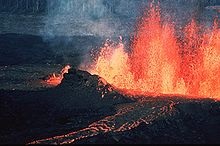|
|
| |
|
|
| |
|
|
|
|
| |
 |
| Extrusive igneous
rock is made from lava released by volcanoes. |
Igneous
Igneous rock (derived from the Latin word ignis meaning
fire), or magmatic rock, is one of the three main rock
types, the others being sedimentary and metamorphic.
Igneous rock is formed through the cooling and
solidification of magma or lava.
The magma can be derived from partial melts of existing
rocks in either a planet's mantle or crust. Typically,
the melting is caused by one or more of three processes:
an increase in temperature, a decrease in pressure, or a
change in composition. Solidification into rock occurs
either below the surface as intrusive rocks or on the
surface as extrusive rocks. Igneous rock may form with
crystallization to form granular, crystalline rocks, or
without crystallization to form natural glasses.
Igneous rocks occur in a wide range of geological
settings: shields, platforms, orogens, basins, large
igneous provinces, extended crust and oceanic crust. |
|
Geological significance
The upper 16 km (10 miles) of the Earth's crust is
composed of about 95% igneous rocks with only a thin,
widespread covering of sedimentary and metamorphic
rocks.
Igneous rocks are geologically important because: |
- their absolute ages may be
determined from various forms of radiometric dating.
This gives information about the dating of adjacent
non-igneous geological strata;
- their features are usually
characteristic of a specific tectonic environment (see
plate tectonics);
- in some special circumstances they
host important mineral deposits (ores): for example,
tungsten, tin, and uranium are commonly associated with
granites and diorites, whereas ores of chromium and
platinum are commonly associated with gabbros.
|
Two types
Igneous rock occurs in two ways. |
- Igneous rock formed from magma that
has become solid inside the earth is called intrusive
igneous rock. Examples of intrusive igneous rock types
are gabbro, diorite, and granite.
- Igneous rock formed from lava that
has become solid on the outside of the Earth is called
extrusive igneous rock. This can happen because of the
eruption of a volcano. Some extrusive igneous rock types
are basalt, andesite, rhyolite, tuff, obsidian, and
pumice.
|
|
Magma
Magma is a complex high-temperature fluid substance.
Temperatures of most magmas are in the range 700 °C to
1300 °C. Magma can get forced into adjacent rocks
(intrusion or plutonic), or forced out to the surface
(extrusion or volcanic) as lava, or blown out in
exposions which include rock pieces (tephra).
Magma is made up of atoms and molecules of melted
minerals. When magma cools the atoms and molecules
rearrange to form mineral grains. Rock forms when
mineral grains (often crystals) grow together. Granite,
diorite, gabbro and basalt are a few types of igneous
rock. Quartz is one of the chief minerals produced by
igneous action; it is made of silica (SiO2), the most
common molecule in igneous minerals. Some examples of
igneous volcanic rock are pumice, obsidian (volcanic
glass), and scoria and much more.
Minerals
Most of the minerals that make up igneous rock are of
these types: |
- Olivines
- Pyroxenes
- Amphiboles
- Micas
- Feldspars & feldspathoids
- Quartz
- Oxides
|
|
Chemical make-up
Igneous rocks can be classified according to their
chemistry. The main types are: |
- Mafic: a silicate mineral or igneous
rock which is rich in magnesium and iron.
- Felsic: silicate minerals, magma,
and igneous rocks which are rich in the lighter elements
such as silicon, oxygen, aluminium, sodium, and
potassium.
|
|
The first six minerals in the list are silicates. Oxides are
mostly of iron. |
|
|
 Kiddle: Igneous Kiddle: Igneous
Wikipedia: Igneous |
|
|
|
|
|
|
|
|
|
|
|
|
|
|
|
|
Search Fun Easy English |
|
|
|
|
|
|
|
|
|
|
|
|
|
|
|
About
Contact
Copyright
Resources
Site Map |